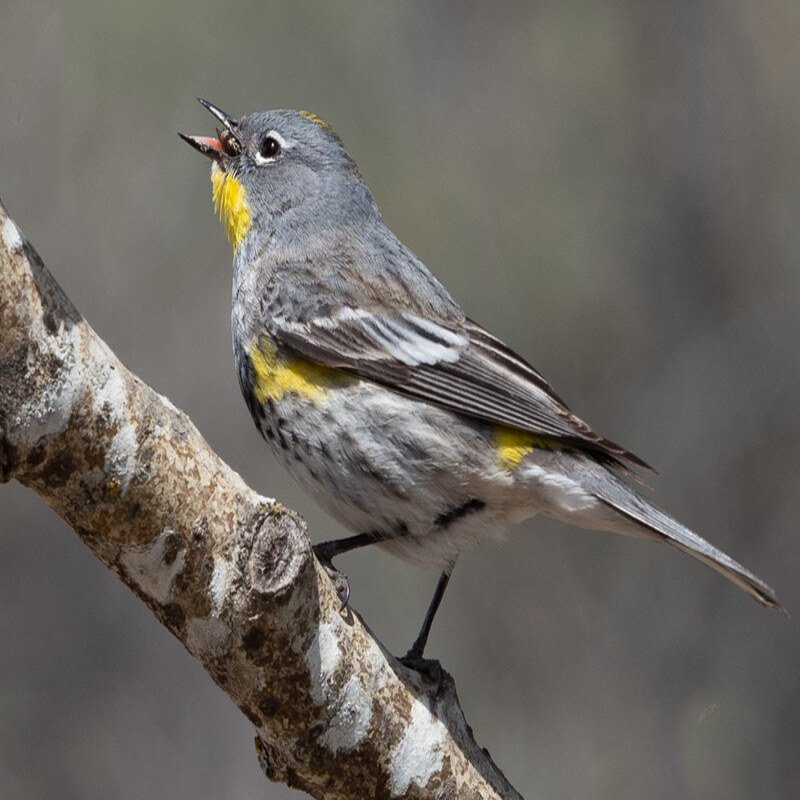The yellow-rumped warbler (Setophaga coronata) is a widespread North American bird found throughout the continent. While all subspecies groups of the yellow-rumped warbler share a yellow rump, despite several similarities, intra-group and inter-group variance in appearance exists. The myrtle and Audubon’s groups, as two primary subspecies, are easily differentiated by distinguishing characteristics such as a different throat color.
Quick Overview: Setophaga Coronata – Yellow-Rumped Warbler
Body size: Around 4.7 – 5-9 in (12-15 cm) and a weight of 12.5 g (0.44 oz)
Main colors: Black, Brown, Gray, White, Yellow
Range: Throughout the United States
Migratory Bird: Yes
Best time of the year to see in the U.S.: March, April, May, September, October, November
Conservation Status: Least Concern
Yellow-Rumped Warbler Description
Male myrtle warblers have black cheeks, but females have brown or gray cheeks, and both have gray backs with dark streaks during breeding season. Males of both Audubon’s subspecies and the myrtle have black on slate blue streaked backs, white wing patches, a streaked breast, and large yellow markings on the head, side, and rump (the latter earning the species the birdwatcher nickname “butter butt”).

Size
These birds have a length of 4.7 – 5-9 in (12-15 cm) and a weight of 12.5 g (0.44 oz). Their wings could range from 7.5-9.4 in (19-24 cm).
Feeding
Insects and berry-bearing plants. Feeds on caterpillars, wasps, grasshoppers, gnats, aphids, beetles, and a variety of other insects; spiders are also a food source. In the winter, it feeds on berries such as bayberry, juniper, wax myrtle, and poison ivy.
Habitat
Yellow-rumped Warblers are forest birds that like open coniferous woods and edges, as well as deciduous forests to a lesser extent. They migrate to open forests and shrubby habitats during the fall and winter, including coastal vegetation, parks, and residential areas.
Behavior
The Audubon’s and Myrtle’s are two of the most common neotropical migrants. They are mostly carnivores. This species is one of the most adaptive foragers. They, like other New World warblers, flit out of their perches in short loops to grab flying insects. Yellow-rumped warblers have been observed collecting insects from washed-up seaweed on beaches, rivers, and oceans, spiderwebs, and dung piles.
Setophaga Coronata Scientific Classification
- Kingdom: Animalia
- Phylum: Chordata
- Class: Aves
- Order: Passeriformes
- Family: Parulidae
- Genus: Setophaga
- Species: Setophaga coronata
Subspecies
The species encompasses four closely similar subspecies: the eastern myrtle warbler (spp. coronata); the western Audubon’s warbler (spp. group auduboni); the northwest Mexican black-fronted warbler (spp. nigrifrons); and the Guatemalan Goldman’s warbler (spp. nigrifrons) (spp. goldmani).
The myrtle and Audubon’s groups, as two primary subspecies, are easily differentiated by distinguishing characteristics such as a different throat color.
Best time of the year to see
In the United States, the best time of year to see these birds are during the Spring season (March-May) and during the Autumn season (September – November).
Distribution of the Yellow-Rumped Warbler in the USA
Its vast distribution spans both the Pacific and Atlantic coastlines of the United States, as well as Canada and Central America, with the population concentrating in northern regions of the continent during the breeding season and moving south to southern North and Central America during the winter.
The Yellow-Rumped Warbler can be found in the following states in the United States – Alabama, Alaska, Arizona, Arkansas, California, Colorado, Connecticut, Delaware, Florida, Georgia, Hawaii, Idaho, Illinois, Indiana, Iowa, Kansas, Kentucky, Louisiana, Maine, Maryland, Massachusetts, Michigan, Minnesota, Mississippi, Missouri, Montana, Nebraska, Nevada, New Hampshire, New Jersey, New Mexico, New York, North Carolina, North Dakota, Ohio, Oklahoma, Oregon, Pennsylvania, Rhode Island, South Carolina, South Dakota, Tennessee, Texas, Utah, Vermont, Virginia, Washington, West Virginia, Wisconsin, and Wyoming.
